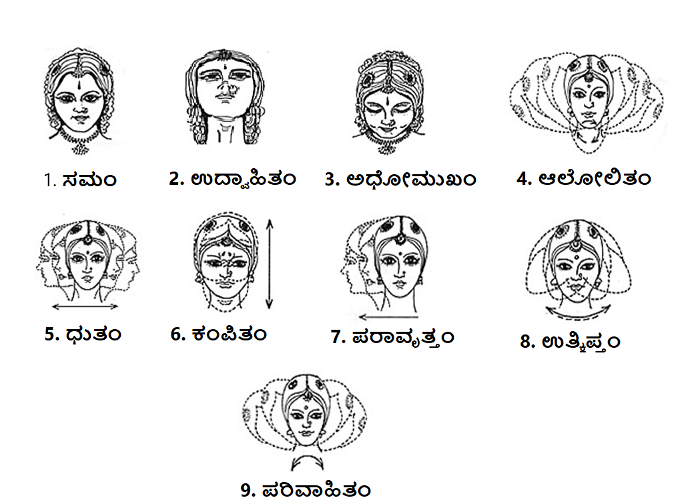
ಶಿರೋ ಭೇಧಗಳು(Śirō bhēdhas)

ಶಿರ ಅಥವಾ ಶಿರಸ ಎಂದರೆ ಸಂಸ್ಕೃತದಲ್ಲಿ “ತಲೆ” ಎಂದರ್ಥ. ತಲೆಯ 9 ಕ್ರಿಯೆಗಳು ನಿರ್ದಿಷ್ಟ ಭಾವವನ್ನು ಸಂವಹಿಸುವಾಗ ತಲೆಯ ಭಂಗಿಗಳನ್ನು ಸೂಚಿಸುತ್ತವೆ.
ಶ್ಲೋಕ:
ಸಮಂ ಉದ್ವಾಹಿತಂ ಅಧೋಮುಖ- ಲೊಲಿತಂ ಧುತಂ |
ಕಂಪಿತಂ ಚ ಪರಾವೃತ್ತ೦ ಉತ್ಕ್ಷಿಪ್ತ೦ ಪರಿವಾಹಿತಂ ||
ನಾವಿಧಾಕಥಿತಂ ಶಿರಸಾ ನಾಟ್ಯಶಾಸ್ತ್ರ ವಿಶಾರದೀ: ||
- ಸಮಂ: ತಲೆಯನ್ನು ನೇರವಾಗಿ ಇರಿಸಿ, ಮುಂದೆ ನೋಡುವುದು.
- ಉದ್ವಾಹಿತಂ: ತಲೆಯನ್ನು ಮೇಲಕ್ಕೆತ್ತಿ, ಆಕಾಶದ ಕಡೆಗೆ ನೋಡುವುದು.
- ಅಧೋಮುಖಂ: ತಲೆಯನ್ನು ಭೂಮಿಯ ಕಡೆಗೆ ನೋಡಲು ತಲೆಯನ್ನು ತಗ್ಗಿಸುವುದು.
- ಆಲೋಲಿತಂ: ವೃತ್ತಾಕಾರದ ಮಾದರಿಯಲ್ಲಿ ತಲೆಯನ್ನು ಚಲಿಸುವುದು.
- ಧುತಂ: ತಲೆಯನ್ನು ದೇಹದ ಬಲಭಾಗಕ್ಕೆ ಮತ್ತು ಎಡಭಾಗಕ್ಕೆ ಪರ್ಯಾಯವಾಗಿ ಸರಿಸಿ
- ಕಂಪಿತಂ: ತಲೆಯನ್ನು ಮೇಲೆ ಹಾಗು ಕೆಳಗೆ ಕಂಪಿಸುವುದು.
- ಪರಾವೃತ್ತ೦: ಬಲಕ್ಕೆ ಅಥವಾ ಎಡಕ್ಕೆ ತಲೆಯ ತ್ವರಿತ ಮತ್ತು ಚುರುಕಾದ ತಿರುವು.
- ಉತ್ಕ್ಷಿಪ್ತ೦: ಇಳಿಜಾರಿನ ನೋಟದಲ್ಲಿ ತಲೆಯನ್ನು ತಿರುಗಿಸಿ ಮತ್ತು ಮೇಲಕ್ಕೆತ್ತಿ.
- ಪರಿವಾಹಿತಂ: ಅರ್ಧವೃತ್ತದ ಮಾದರಿಯಲ್ಲಿ ತಲೆಯ ಚಲನೆ, ಒಂದು ಬದಿಯಿಂದ ಇನ್ನೊಂದು ಕಡೆಗೆ.
Shira or shirasa means” head” in Sanskrit. The nine head actions indicate the head postures when communicating specific bhava.
Shloka:
Sama udvahitam adhomukha-lolitam Dhutam|
kampitam cha paravrittam ukshiptam parivahitam||
navdhakathitam shirasa natyashastra visharadaihi||
- Samam: Keeping the head straight, looking front.
- Udvahitham: Looking up towards the sky.
- Adhomukham: Look Down towards earth.
- Alolitam: Moving head in a circular pattern.
- Dhutam: Move the head to the right side of the body and the left side.
- Kampitam: Nodding up and down.
- Paravrittam: A quick brisk turn of the head to the right or left.
- Ukshiptam: Turn the head and raise or in a sloped view.
- Parivahittam: Movement of the head from one side to another.